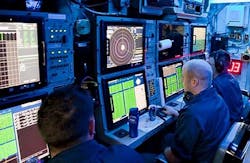Officials of the U.S. Defense Advanced Research Projects Agency (DARPA) have awarded contracts to Systems & Technology Research (STR) LLC in Woburn, Mass., and to Applied Physical Sciences Corp. (APS) in Groton, Conn., for the Tactical Exploitation Of The Acoustic Channel (TEAC) program.
TEAC seeks to form a distributed source network that can combine sonar signals from several distributed emitters into a coherent signal at one location for applications like active sonar, acoustic surveillance, and underwater communications.
In underwater applications, phased-array sonar traditionally consists of a fixed set of physically connected transmitters, which requires cumbersome cabling, challenging deployment, and the inability to reconfigure the array aperture, DARPA researchers explain.
Related: DARPA eyes bistatic sonar with UUV-based pingers to preserve stealth of attack submarines
Instead, DARPA seeks to use the TEAC program in an alternate approach to form a distributed source network that can gather signals from each distributed sonar transmitter and render a coherent signal at a desired location.
In their TEAC work, experts from STR and APS will develop and demonstrate a phased array sonar formed from a semi-autonomous distributed network of sources on several undersea platforms.
DARPA officials say they are interested in developing a system with a modest number of independent distributed acoustic transmitters that can increase the signal-to-noise ratio (SNR) and focus the acoustic energy from the transmitters at the receiver.
The program seeks to harness advances in undersea vehicles and acoustic source technologies to enable long-duration sonar transmitter payloads on relatively small and affordable platforms.
Related: Sonar technology comes to grips with dangerous new era
The ability to cohere several moving sources underwater is very challenging, DARPA officials point out. It requires the ability to estimate the positions of sonar transmitters relative to each other to introduce the appropriate time delay or complex phase.
Such technology also might require channel and motion mitigation, depending on the diversity of the underwater propagation and the motion of sonar transmitters.
Experts from STR and APS may use inter-source communications for localization and coordination, but will have to address potential communication delays, DARPA researchers say.
Related: Technology comes to bear on radar and sonar
If successful, the TEAC program will provide a flexible and scalable source network with the ability to configure and cohere several sources dynamically and semi-autonomously.
STR and APS will work on the TEAC program's first phase, and will have options for the second phase if initial work is promising. STR won a $12.1 million contract last week, with a phase-two option of $11.3 million. APS won a $6.2 million TEAC phase-one contract last month, with a $5.4 million option for phase two. More TEAC contracts could be awarded.
For more information contact STR online at www.stresearch.com, APS at www.aphysci.com, or DARPA at www.darpa.mil.
Ready to make a purchase? Search the Military & Aerospace Electronics Buyer's Guide for companies, new products, press releases, and videos



